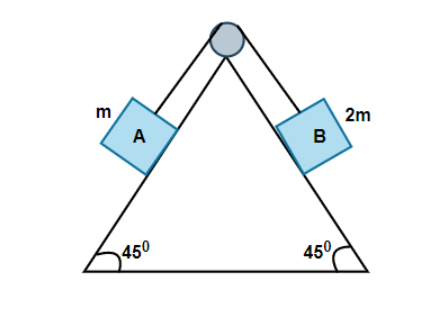
The velocity vector $v$ and displacement vector $x$of a particle executing SHM are related as \[V\dfrac{{dv}}{{dx}} = - {w^2}x\] with the initial condition \[v = {v_0}\]at \[x = 0\] the velocity \[{v_s}\] when displacement is$x$, is
(A) \[v = \sqrt {v{}_0^2 + {w^2}{x^2}} \]
(B) \[v = \sqrt {v{}_0^2 - {w^2}{x^2}} \]
(c) \[v = \sqrt {v{}_0^3 + {w^3} + {x^3}} \]
(D) \[v = {v_0} - {({w^3}{x^3}{e^x}^{^3})^{\dfrac{1}{3}}}\]

Answer
226.5k+ views
Hint In mechanics and physics, simple harmonic motion is a special type of periodic motion where the restoring force on the moving object is directly proportional to the object's displacement magnitude and acts towards the object's equilibrium position. It is vibratory motion in a system in which the restoring force is proportional to the displacement from equilibrium
Step by step solution
As it is Simple harmonic motion so the equation of motion will be
\[F = - kx\]
Or the equation can be written as
\[\dfrac{{vdv}}{{dx}} = - {\omega ^2}x\]
Now integrating the expression with boundary condition,
\[\int\limits_{{v_0}}^v {vdv} = - {\omega ^2}\int\limits_0^x {xdx} \]
After integrating the above equation we get
$\left[ {\dfrac{{{v^2}}}{2}} \right]_{{v_0}}^v = - {\omega ^2}\left[ {\dfrac{{{x^2}}}{2}} \right]_0^x$
Now we have to apply the limit in the above equation so we get
$\left[ {\dfrac{{{v^2}}}{2} - \dfrac{{v_0^2}}{2}} \right] = - {\omega ^2}\left[ {\dfrac{{{x^2}}}{2}} \right]$
Now we have to do further calculation then we get
$\dfrac{1}{2}\left[ {{v^2} - v_0^2} \right] = \dfrac{{ - {\omega ^2}{x^2}}}{2}$
Now after simplifying the above equation we get
$v = \sqrt {v{}_0^2 - {\omega ^2}{x^2}} $
Hence the correct answer is option is (B)
Note
A speed vector speaks to the pace of progress of the situation of an object.The greatness of a speed vector gives the speed of an article while the vector course gives its direction.Velocity vectors can be added or deducted by the standards of vector addition.In math and mechanics, a relocation is a vector whose length is the most limited good ways from the underlying to the last situation of a point P going through movement. It quantifies both the distance and direction of the net or total motion along a straight line from the initial position to the final position of the point trajectory. A displacement may be identified with the translation that maps the initial position to the final position.
Step by step solution
As it is Simple harmonic motion so the equation of motion will be
\[F = - kx\]
Or the equation can be written as
\[\dfrac{{vdv}}{{dx}} = - {\omega ^2}x\]
Now integrating the expression with boundary condition,
\[\int\limits_{{v_0}}^v {vdv} = - {\omega ^2}\int\limits_0^x {xdx} \]
After integrating the above equation we get
$\left[ {\dfrac{{{v^2}}}{2}} \right]_{{v_0}}^v = - {\omega ^2}\left[ {\dfrac{{{x^2}}}{2}} \right]_0^x$
Now we have to apply the limit in the above equation so we get
$\left[ {\dfrac{{{v^2}}}{2} - \dfrac{{v_0^2}}{2}} \right] = - {\omega ^2}\left[ {\dfrac{{{x^2}}}{2}} \right]$
Now we have to do further calculation then we get
$\dfrac{1}{2}\left[ {{v^2} - v_0^2} \right] = \dfrac{{ - {\omega ^2}{x^2}}}{2}$
Now after simplifying the above equation we get
$v = \sqrt {v{}_0^2 - {\omega ^2}{x^2}} $
Hence the correct answer is option is (B)
Note
A speed vector speaks to the pace of progress of the situation of an object.The greatness of a speed vector gives the speed of an article while the vector course gives its direction.Velocity vectors can be added or deducted by the standards of vector addition.In math and mechanics, a relocation is a vector whose length is the most limited good ways from the underlying to the last situation of a point P going through movement. It quantifies both the distance and direction of the net or total motion along a straight line from the initial position to the final position of the point trajectory. A displacement may be identified with the translation that maps the initial position to the final position.
Recently Updated Pages
Uniform Acceleration Explained: Formula, Examples & Graphs

JEE Main Admit Card 2026: Releasing Soon – Download Hall Ticket at jeemain.nta.nic.in

JEE Main Marks Vs Percentile 2026: Calculate Percentile Based on Marks

AP EAPCET 2026 Exam Dates (OUT), Eligibility, Syllabus, Result, and Counselling

JEE Main 2026 Exam Pattern Released: Total Questions, and Marks, and Marking Scheme

300 Marks in JEE Main Percentile Rank IIT CSE Chances

Trending doubts
JEE Main 2026: City Intimation Slip and Exam Dates Released, Application Form Closed, Syllabus & Eligibility

JEE Main 2026 Application Login: Direct Link, Registration, Form Fill, and Steps

Understanding the Angle of Deviation in a Prism

Hybridisation in Chemistry – Concept, Types & Applications

How to Convert a Galvanometer into an Ammeter or Voltmeter

Ideal and Non-Ideal Solutions Explained for Class 12 Chemistry

Other Pages
JEE Advanced Marks vs Ranks 2025: Understanding Category-wise Qualifying Marks and Previous Year Cut-offs

Laws of Motion Class 11 Physics Chapter 4 CBSE Notes - 2025-26

JEE Advanced 2026 - Exam Date (Released), Syllabus, Registration, Eligibility, Preparation, and More

Mechanical Properties of Fluids Class 11 Physics Chapter 9 CBSE Notes - 2025-26

Thermodynamics Class 11 Physics Chapter 11 CBSE Notes - 2025-26

Units And Measurements Class 11 Physics Chapter 1 CBSE Notes - 2025-26




